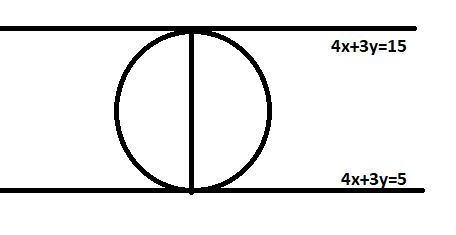
The area( in square unit) of the circle which touches the lines \[4x + 3y = 15\]and \[{\text{4x + 3y = 5}}\]is \[{\text{m$\pi$ }}\]. Find m.
Answer
577.8k+ views
Hint: We have two lines as \[4x + 3y = 15\]and \[4x + 3y = 15\]. We can see both lines are parallel altogether. So using the formula for distance between two parallel lines, which is the perpendicular distance between two parallel lines, \[ax + by + c = 0\]and \[ax + by + d = 0\]is denoted by, \[\dfrac{{\left| {{\text{c - d}}} \right|}}{{\sqrt {{{\text{a}}^{\text{2}}}{\text{ + }}{{\text{b}}^{\text{2}}}} }}\]units, we’ll find the diameter of the circle resulting in the radius. So, using the radius we’ll find the area of the circle using the formula of area of the circle which is \[{\text{$\pi$ (radius}}{{\text{)}}^{\text{2}}}\], and then comparing it with the given area of circle, we find the value of m.
Complete step by step Answer:
Here, We have two lines as \[4x + 3y = 15\]and \[4x + 3y = 15\].
And it is clear that they are parallel.

Since both lines are parallel, (visible from the image)
So, we will have the Diameter=the perpendicular distance between two lines,
Now the perpendicular distance between two lines, \[ax + by + c = 0\]and \[ax + by + d = 0\]is denoted by,
\[\dfrac{{\left| {{\text{c - d}}} \right|}}{{\sqrt {{{\text{a}}^{\text{2}}}{\text{ + }}{{\text{b}}^{\text{2}}}} }}\]units
So, we have here, \[{\text{a = 4, b = 3, c = - 15,d = - 5,}}\]
The perpendicular distance would be,
\[\dfrac{{\left| {{\text{ - 15 - ( - 5)}}} \right|}}{{\sqrt {{\text{16 + 9}}} }}\]units
\[{\text{ = }}\dfrac{{{\text{10}}}}{{\text{5}}}{\text{ = 2units}}\]
So, Diameter is 2 units,
Now, the radius is, \[\dfrac{{\text{D}}}{{\text{2}}}{\text{ = }}\dfrac{{\text{2}}}{{\text{2}}}{\text{ = 1}}\]units,
We are finding the area now, so, area= \[{\text{$\pi$ (radius}}{{\text{)}}^{\text{2}}}\]=\[{\text{$\pi$ (1}}{{\text{)}}^{\text{2}}}\]\[{\text{ = $\pi$ }}\]units
So, we have, \[{\text{m$\pi$ = $\pi$ }}\]
So, \[{\text{m = 1}}\].
Note: The perpendicular distance formula of the lines is used here. We see the perpendicular distance between two lines, \[ax + by + c = 0\]and \[ax + by + d = 0\]is denoted by,
\[\dfrac{{\left| {{\text{c - d}}} \right|}}{{\sqrt {{{\text{a}}^{\text{2}}}{\text{ + }}{{\text{b}}^{\text{2}}}} }}\]units.
We can also find the distance between two lines by taking any point on one line and then by using the formula for a point from a line i.e.
Let the point be (l,m) and equation of line be ax+by+c=0
The distance between them\[\dfrac{{\left| {{\text{lx + bm + c}}} \right|}}{{\sqrt {{{\text{a}}^{\text{2}}}{\text{ + }}{{\text{b}}^{\text{2}}}} }}\]
After finding the diameter you should not forget to find its radius first and then the area, otherwise, the answer would be wrong.
Complete step by step Answer:
Here, We have two lines as \[4x + 3y = 15\]and \[4x + 3y = 15\].
And it is clear that they are parallel.

Since both lines are parallel, (visible from the image)
So, we will have the Diameter=the perpendicular distance between two lines,
Now the perpendicular distance between two lines, \[ax + by + c = 0\]and \[ax + by + d = 0\]is denoted by,
\[\dfrac{{\left| {{\text{c - d}}} \right|}}{{\sqrt {{{\text{a}}^{\text{2}}}{\text{ + }}{{\text{b}}^{\text{2}}}} }}\]units
So, we have here, \[{\text{a = 4, b = 3, c = - 15,d = - 5,}}\]
The perpendicular distance would be,
\[\dfrac{{\left| {{\text{ - 15 - ( - 5)}}} \right|}}{{\sqrt {{\text{16 + 9}}} }}\]units
\[{\text{ = }}\dfrac{{{\text{10}}}}{{\text{5}}}{\text{ = 2units}}\]
So, Diameter is 2 units,
Now, the radius is, \[\dfrac{{\text{D}}}{{\text{2}}}{\text{ = }}\dfrac{{\text{2}}}{{\text{2}}}{\text{ = 1}}\]units,
We are finding the area now, so, area= \[{\text{$\pi$ (radius}}{{\text{)}}^{\text{2}}}\]=\[{\text{$\pi$ (1}}{{\text{)}}^{\text{2}}}\]\[{\text{ = $\pi$ }}\]units
So, we have, \[{\text{m$\pi$ = $\pi$ }}\]
So, \[{\text{m = 1}}\].
Note: The perpendicular distance formula of the lines is used here. We see the perpendicular distance between two lines, \[ax + by + c = 0\]and \[ax + by + d = 0\]is denoted by,
\[\dfrac{{\left| {{\text{c - d}}} \right|}}{{\sqrt {{{\text{a}}^{\text{2}}}{\text{ + }}{{\text{b}}^{\text{2}}}} }}\]units.
We can also find the distance between two lines by taking any point on one line and then by using the formula for a point from a line i.e.
Let the point be (l,m) and equation of line be ax+by+c=0
The distance between them\[\dfrac{{\left| {{\text{lx + bm + c}}} \right|}}{{\sqrt {{{\text{a}}^{\text{2}}}{\text{ + }}{{\text{b}}^{\text{2}}}} }}\]
After finding the diameter you should not forget to find its radius first and then the area, otherwise, the answer would be wrong.
Recently Updated Pages
Master Class 11 Economics: Engaging Questions & Answers for Success

Master Class 11 English: Engaging Questions & Answers for Success

Master Class 11 Social Science: Engaging Questions & Answers for Success

Master Class 11 Biology: Engaging Questions & Answers for Success

Class 11 Question and Answer - Your Ultimate Solutions Guide

Master Class 11 Business Studies: Engaging Questions & Answers for Success

Trending doubts
What is meant by exothermic and endothermic reactions class 11 chemistry CBSE

1 Quintal is equal to a 110 kg b 10 kg c 100kg d 1000 class 11 physics CBSE

What is periodicity class 11 chemistry CBSE

Explain zero factorial class 11 maths CBSE

What is a periderm How does periderm formation take class 11 biology CBSE

What are porins class 11 biology CBSE




